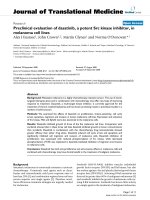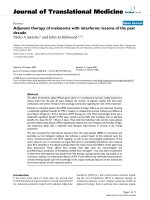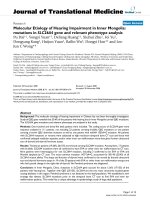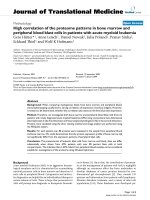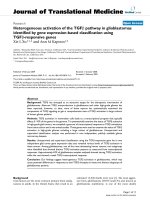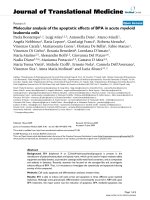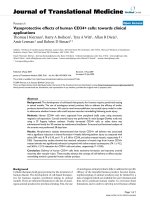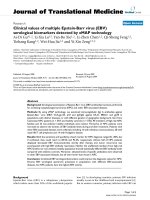báo cáo hóa học:" Feasibility investigation of allogeneic endometrial regenerative cells" pdf
Bạn đang xem bản rút gọn của tài liệu. Xem và tải ngay bản đầy đủ của tài liệu tại đây (272.58 KB, 7 trang )
BioMed Central
Page 1 of 7
(page number not for citation purposes)
Journal of Translational Medicine
Open Access
Research
Feasibility investigation of allogeneic endometrial regenerative cells
Zhaohui Zhong
1
, Amit N Patel
2
, Thomas E Ichim*
3
, Neil H Riordan
3
,
Hao Wang
4
, Wei-Ping Min
4
, Erik J Woods
5
, Michael Reid
6
,
Eduardo Mansilla
7
, Gustavo H Marin
7
, Hugo Drago
7
, Michael P Murphy
8
and
Boris Minev
9,10
Address:
1
The Second Xiangya Hospital, Central South University, Changsha, PR China,
2
Department of Cardiothoracic Surgery, University of
Utah, Salt Lake City, USA,
3
Medistem Inc, San Diego, USA,
4
Department of Surgery, University of Western Ontario, Canada,
5
General
Biotechnology LLC, Indiana, USA,
6
Body in Motion Consulting, Kitchener, Canada,
7
Burns Hospital, Buenos Aires City, Argentina,
8
Division of
Vascular Surgery, Indiana University School of Medicine, Indiana, USA,
9
Moores Cancer Center, University of California, San Diego and
10
Division
of Neurosurgery, University of California San Diego, San Diego, USA
Email: Zhaohui Zhong - ; Amit N Patel - ; Thomas E Ichim* - ;
Neil H Riordan - ; Hao Wang - ; Wei-Ping Min - ;
Erik J Woods - ; Michael Reid - ; Eduardo Mansilla - ;
Gustavo H Marin - ; Hugo Drago - ; Michael P Murphy - ;
Boris Minev -
* Corresponding author
Abstract
Endometrial Regenerative Cells (ERC) are a population of mesenchymal-like stem cells having
pluripotent differentiation activity and ability to induce neoangiogenesis. In vitro and animal studies
suggest ERC are immune privileged and in certain situations actively suppress ongoing immune
responses. In this paper we describe the production of clinical grade ERC and initial safety
experiences in 4 patients with multiple sclerosis treated intravenously and intrathecally. The case
with the longest follow up, of more than one year, revealed no immunological reactions or
treatment associated adverse effects. These preliminary data suggest feasibility of clinical ERC
administration and support further studies with this novel stem cell type.
Introduction
Endometrial Regenerative Cells (ERC) are a population of
plastic adherent, mesenchymal-like stem cells that are
possess in vitro pluripotency, and in vivo therapeutic
activity in models of limb ischemia and infarcts [1-4].
Phenotypically ERC appear to share some markers with
mesenchymal stem cells such as CD90 and CD105 but are
unique in that they express hTERT and OCT-4 [1,2].
Immunological characterization of ERC revealed hypoim-
munogenicity when used as stimulators in mixed lym-
phocyte reaction, as well as active suppression of
proliferating T cells in vitro. In vivo ERC appear to induce
therapeutic effects in immune competent xenogeneic
recipients [4]. Thus theoretically ERC may be useful as an
allogeneic "off-the-shelf" therapy.
The use of allogeneic cells as a therapeutic approach in
immune competent recipients has previously been per-
formed with bone marrow derived mesenchymal stem
cells (MSC) which are known to inhibit ongoing mixed
lymphocyte reaction (MLR) [5], induce generation of T
regulatory cells [6], and suppress autoimmunity in vivo in
Published: 20 February 2009
Journal of Translational Medicine 2009, 7:15 doi:10.1186/1479-5876-7-15
Received: 15 January 2009
Accepted: 20 February 2009
This article is available from: />© 2009 Zhong et al; licensee BioMed Central Ltd.
This is an Open Access article distributed under the terms of the Creative Commons Attribution License ( />),
which permits unrestricted use, distribution, and reproduction in any medium, provided the original work is properly cited.
Journal of Translational Medicine 2009, 7:15 />Page 2 of 7
(page number not for citation purposes)
conditions such as collagen induced arthritis [7] and
experimental allergic encephalomyelitis [8]. In animal
models, acceleration of wound healing [9], or post-infarct
recovery [10], has been accomplished by administration
of allogeneic mesenchymal cells.
Allogeneic MSC therapy is a clinical reality. For example,
cord blood derived MSC have also demonstrated benefit
in a patients with critical limb ischemia caused by
Buerger's Disease [11]. Allogeneic bone marrow derived
MSC have been used by academic investigators for treat-
ment of diseases such as graft versus host (GVHD) [12-
17], osteogenesis imperfecta [18], Hurler syndrome, met-
achromatic leukodystrophy [19], and acceleration of
hematopoietic stem cell engraftment [20-22] with clinical
benefit. The company Osiris Therapeutics has successfully
completed Phase I safety studies using allogeneic MSCs
and has currently ongoing Phase II and Phase III trials for
Type I Diabetes, Crohn's Disease, and Graft Versus Host
Disease using allogeneic bone marrow derived MSC [23].
Intravenous administration of allogeneic MSCs by Osiris
was also reported to induce a statistically significant
improvement of cardiac function of MI patients in a dou-
ble-blind study [24]. Other companies have entered clini-
cal trials using allogeneic MSC-based products. Athersys is
currently in Phase I trials using its MultiStem™ technol-
ogy, which involves ex vivo expanded multipotent adult
progenitor cells (MAPC) for post-infarct heart repair [25].
Angioblast Systems has recently announced initiation of
Phase II trials using Mesenchymal Precursor Cells™ for
stimulation of cardiac angiogenesis [26]. Neuronyx is cur-
rently performing Phase I clinical trials using allogeneic
human adult bone marrow-derived somatic cells (hABM-
SC) for post infarct healing [27].
Given the general clinical safety profile of MSC from other
sources, we conducted initial studies to determine the
safety profile of ERC. We have previously demonstrated
karyotypical stability up to 68 doublings [1], as well as
lack of tumor formation ability or tumor acceleration in
animal models [4]. In this short report we detail expan-
sion, quality control, and initial safety data from patients
treated under compassionate use in a physician-initiated
setting. A detailed description of the therapeutic effects
and rationale for use in the indications described will be
provided in subsequent publications.
Methods
Patients
Four patients were treated as part of a compassionate use,
physician initiated program. All patients have been
accepted by an independent medical review board deem-
ing that the patients have failed all standard treatment
options. Additionally, local IRB approval for the general
protocols and procedures is in place. All patients were not
allergic to penicillin or ciprofloxacin.
Donors
Donors were selected after rigorous testing according to
federal regulation 21 CFR1271 regarding allogeneic cell
products. Specifically, healthy, non-smoking, female vol-
unteers between 18–30 years of age signed informed con-
sent form for providing menstrual blood sample. The
volunteers underwent a standard medical history and
physical examination, as well as evaluation for malig-
nancy, diabetes, heart disease, in addition to CBC and
metabolic panel. Only donors negative for HIV-1, HIV-2,
HTLV-II, hepatitis B surface antigen, hepatitis B core anti-
gen, hepatitis C, VDRL, papilloma virus and trypanosome
cruzi were allowed to participate in this study.
Collection
Before the collection procedure a "collection tube" was
prepared in a class 100 Biological Safety Cabinet located
in a Class 10,000 Clean Room. To prepare the collection
tube, 0.2 ml amphotericin B (Sigma-Aldrich, St Louis,
MO), 0.2 ml penicillin/streptomycin (Sigma) and 0.1 ml
EDTA-Na2 (Sigma) were added to a 50 ml conical tube
containing 30 ml of GMP-grade phosphate buffered
saline (PBS). Collection of 5 ml of menstrual blood was
performed according to a modification of our published
procedure [1]. Collection was performed by the donor. A
sterile Diva cup was inserted into the vagina and left in
place for 30–60 minutes. After removal, the contents of
the Diva cup were decanted into the collection tube. The
collection tube was then taken to the clean room where it
was centrifuged at 600 g for 10 minutes. The collection
tube was then transported to the Biological Safety Cabinet
where the supernatant was removed, and the tube was
topped up to 50 ml with PBS in the Biological Safety Cab-
inet and cells were washed by centrifugation at 600 g for
10 minutes at room temperature. The cell pellet was
washed 3 times with 50 ml of PBS, and mononuclear cells
were collected by Ficoll-Paque (Fisher Scientific, Port-
smouth NH) density gradient. Mononuclear cells were
washed 3 times in PBS and resuspended in 5 ml complete
DMEM-low glucose medium (GibcoBRL, Grand Island,
NY) supplemented with 10% Fetal Bovine Serum selected
lots having endotoxin level < = 10 EU/ml, and hemo-
globin level < = 25 mg/dl clinical grade ciprofloxacin (5
mg/mL, Bayer A.G., Germany) and 4 mM L-glutamine
(cDMEM). The serum lot used was sequestered and one
lot was used for all experiments. The resulting cells were
mononuclear cells substantially free of erythrocytes and
polymorphonuclear leukocytes as assessed by visual mor-
phology microscopically. Viability of the cells was
assessed using a Guava EasyCyte Mini flow cytometer,
Viacount reagents, Cytosoft Software version 4.2.1, Guava
Technologies, inc. Hayward, CA (Guava flow cytometer).
Journal of Translational Medicine 2009, 7:15 />Page 3 of 7
(page number not for citation purposes)
Only samples with > 90% viability were selected for cul-
ture.
Expansion
Cells were plated in a T-75 flask containing 15 ml of
cDMEM and cultured for 24 hours at 37°C at 5% CO2 in
a fully humidified atmosphere. This allows the ERC pre-
cursors to adhere. Non-adherent cells were washed off
using cDMEM by gentle rinsing of the flask. Adherent cells
were subsequently detached by washing the cells with PBS
and addition of 0.05% trypsin containing EDTA (Gibco,
Grand Island, NY, USA) for 2 minutes at 37°C at 5% CO2
in a fully humidified atmosphere. Cells were centrifuged,
washed and plated in T-175 flask in 30 ml of cDMEM.
This results in approximately 10,000 ERC per initiating T-
175 flask. The flask was then cultured for 5 days which
yields approximately 1 million cells in the T-175 flask
(passage 1). Subsequently cells were passaged at approxi-
mately 200,000 cells in a T-175 flask. At passage 3–4,
approximately 100–200 million cells were harvested.
Characterization and release criteria
Cells aliquots from each donor batch have met the follow-
ing release criteria: (i) negative for bacterial and myco-
plasma contamination; (ii) endotoxin levels < 1.65 EU/
ml; (iii) morphology consistent with adherent, fibroblas-
tic-like shape; (iv) CD90 and CD105 positive (> 90%)
and CD45 and CD34 negative (< 5%) by flow cytometry;
(v) Cell viability > 95% by trypan blue staining and Guava
flow cytometer. In addition, karyotypic normality of the
cells was also assessed by an independent laboratory for
each batch.
Administration
Intravenous administration was performed by intrave-
nous injection using USP-grade saline and autologous
heat inactivated serum (50%). Administration time was
10 minutes approximately 1 million cells/ml were
injected. For intrathecal injection, 6 million ERC's cells in
USP-grade clinical normal saline (Baxter) and autologous
heat inactivated serum (50%) were drawn in a 10 ml
syringe. The syringe was attached to the lumbar puncture
needle. In order to ensure the needle was still in the CSF,
the plunger was drawn back to aspirate a small volume of
CSF. The volume of 6 ml was injected slowly with the
patient repeatedly asked if there was pain during the injec-
tion process. At no time was there resistance in the proce-
dure. Once the cell solution has been injected into the CSF
the plunger of the syringe was kept fully depressed and the
syringe and lumbar puncture needle removed together.
The injection site and general condition of the patient was
monitored for 30 minutes after the first and each subse-
quent administration at the hospital to look for a possible
allergic reaction.
Case reports
The patients were treated as part of a compassionate use,
physician initiated program. Since patients received other
medical interventions and therapies in addition to ERC,
only safety parameters will be discussed in this report.
Summarized details of the patients and treatments are
provided in Table 1. Overall safety evaluations performed
are depicted in Table 2.
Patient 1: Multiple Sclerosis (AA) Intravenous and
Intrathecal
This 47-year-old patient was diagnosed with multiple scle-
rosis in November 2000. Due to severe pain in the left arm
and right leg refractory to medication, as well as fatigue
and impaired mobility, the patient sought non-conven-
tional treatment options in December 2006. The patient
presented in July of 2007. After being explained the exper-
imental nature of the proposed procedure, informed con-
sent was obtained. Administration of 3 million ERC was
performed intravenously on days 1, 3, and 4; on day 2 she
received an intrathecal injection with ERC's. No adverse
reactions were noted at the time of administration. On
July 24, 2008, the patient returned for a follow-up exami-
nation and requested additional ERC treatment. This
opportunity was used to perform a physical exam, chest x-
ray, complete blood count, serum biochemistry, CEA,
alpha-fetoprotein, fecal occult blood. All of these tests
generated no evidence of abnormality. The physical exam
emphasized the injection site, which revealed no inflam-
mation, masses or abnormalities. Telephone interview
Table 1: Summary of Patients Treated
Patient Condition Route Total Injected Follow Up Notable Events
AA MS IV & IT 16 million 12 months None
PW MS IT 30 million 2 months None
RH MS IT 30 million 2 months None
JU MS IT 30 million 5 months None
Journal of Translational Medicine 2009, 7:15 />Page 4 of 7
(page number not for citation purposes)
with the patient on December 2008 revealed no notable
events or abnormities.
Patient 2: Multiple Sclerosis: (PW) Intrathecal
According to his neurologist, this 39-year-old patient first
started noting signs of fatigue in 1995, with staggering gait
and cognitive decline. The patient had never experienced
any relapse remitting type of presentation. The patient
presented in May 2008, requesting experimental stem cell
therapy. After being explained the nature of the procedure
and possible adverse effects, the patient signed an
informed consent form. Administration of 5 intrathecal
injections of 6 million ERC was performed on days 1, 3,
6, 8, and 10. Examination of the injection area was made
prior to subsequent injections and release of the patient.
No inflammatory lesions or abnormalities were observed.
Importantly, physical and neurological examination did
not reveal abnormalities, or inflammatory lesions at injec-
tion site. Complete blood counts and serum biochemistry
was unremarkable as of July 22, 2008. Telephone inter-
view with the patient on December 2008 revealed no
notable events or abnormities.
Patient 3: Multiple Sclerosis: (RH) Intrathecal
This 53-year-old male patient was diagnosed with Relaps-
ing-remitting MS in 2005. In May 2008, the patient was
treated with five intrathecal infusions of 6 million ERC.
All infusions were performed within a 9-day period and
were very well tolerated without any significant side
effects. During the infusions we observed no adverse or
side effects. No local or systemic effects were noted. After
each infusion the patient was observed for 15 to 20 min-
utes to look for a possible allergic reaction, but no such
reaction was noted. In September 2008, the patient under-
went a panel of post-treatment medical evaluation tests,
including CBC, stool culture, basic metabolic panel, liver
function panel, CEA and PSA. All tests revealed no abnor-
malities. Telephone interview with the patient on Decem-
ber 2008 revealed no notable events or abnormities.
Patient 4 Multiple Sclerosis (JU) Intrathecal
This 36-year-old male patient was diagnosed with Relaps-
ing-remitting MS in September of 1993. His presenting
symptoms in January of 1993 were noticeable tingling
and burning sensation in the right leg, followed by lower
body paralysis lasting almost three weeks. In 2007 he was
treated with Tysabri (Natalizumab, Biogen Idec) for 6
months without success. The patient's condition deterio-
rated significantly and he was immobilized most of the
time with severe pain in the coccygeal area, significantly
impacted balance and coordination, very low energy level,
heat sensitivity, bowel and bladder function difficulties,
and substantial fatigue and depression. Although the pain
was treated well with Carbamazepine, the patient was on
full disability in 2007 and the first half of 2008. In June of
2008, the patient was treated with five intrathecal infu-
sions of 6 million ERC. All infusions were performed
within a 9-day period and were very well tolerated with-
out any significant side effects. The only noted side effect
was mild self-limiting headache, a common side effect of
lumbar puncture (Reference Feron). After each infusion
the patient was observed for 15 to 20 minutes to look for
a possible allergic reaction, but no such reaction was
noted. In August 2008, the patient underwent a physical
examination and several post-treatment evaluation tests,
including CBC, basic metabolic panel, liver function
panel, CEA and PSA. All tests revealed no abnormalities.
PA and lateral chest X-ray views revealed normal findings
with a minimal patchy lingular atelectasis. Telephone
interview with the patient on December 2008 revealed no
notable events or abnormities.
Discussion
In this study we demonstrated for the first time feasibility
of administration of ERC-based cell therapy in four
patients with MS. This "off-the-shelf" allogeneic ERC ther-
apy could conceptually have several positive aspects such
as: a) ease of administration; b) ability to use optimized
cells; and c) administration of multiple doses. The most
clinically advanced form of stem cell therapy, hematopoi-
etic stem cells, either extracted from bone marrow by iliac
crest puncture, or by G-CSF mobilization, has demon-
strated varying degrees of efficacy in conditions such as
heart failure [28,29], liver failure [30,31], peripheral
artery disease [32-35], and spinal cord injury [36-38]. The
effects of bone marrow stem cell-based treatments appear
Table 2: Safety Parameters
Patient Physical Exam CBC/Biochem Panel Fecal Occult Blood Chest X-Ray PSA, CEA, alpha fetoprotein
AA X X X X X
PW X X X X X
RH X X ND X X
JU X X ND ND X
Journal of Translational Medicine 2009, 7:15 />Page 5 of 7
(page number not for citation purposes)
to be primarily due to trophic support through secretion
of various growth factors [39,40], stimulation of angio-
genesis [41], and possibly fusion/transdifferentiation [42-
44], although this latter possibility is quite controversial
[45]. Unfortunately, autologous approaches are limited
by the considerable inter-individual heterogeneity in the
stem cell activity. For example, older patients are known
to have reduced bone marrow stem cell regenerative activ-
ity, as well as lower angiogenic potential, as compared to
younger people [46]. Additionally, patients with cardio-
vascular risk factors have severely compromised regenera-
tive potential compared to age-matched controls [47].
Accordingly, an "off-the-shelf", standardized stem cell
population would be a much more attractive treatment
alternative for a variety of immunomodulatory and regen-
erative indications.
The concept of "off-the-shelf" stem cell therapies has been
clinically performed in trials using bone marrow derived
MSC. The extensive clinical experience with these cells
demonstrates no evidence of adverse effects in over 10
clinical trials to date [12-22]. Given that ERC are derived
from the endometrium, we suggested that these cells
might be able to support the angiogenesis in the model of
critical limb ischemia [4]. Our preliminary results demon-
strate superior angiogenic potential of ERC compared to
bone marrow derived MSC, and our published data
showed superior growth factor production as compared to
placental MSC [1]. Additionally, it has been reported that
ERC and ERC-like cells are capable of differentiating into
9 different tissues including cardiac, hepatic, pancreatic,
bone, adipose, cartilage, endothelial, neural, and pulmo-
nary tissues [1,2]. In contrast, freshly isolated bone mar-
row derived MSC do not appear to possess such
pluripotency unless extensively manipulated ex vivo.
Therefore, there is a possibility that ERC may be useful for
numerous clinical indications. Hida et al demonstrated in
vivo cardiac repair using a menstrual blood derived cell
type possessing some similarity to the ERC [3].
ERC possess various characteristics similar to MSC includ-
ing ability to immune modulate [4] and induce Treg pro-
duction [48]. MSC have been previously demonstrated to
inhibit induction and progression of experimental allergic
encephalomyelitis (EAE), a rodent model of multiple scle-
rosis [8]. Furthermore, introduction of MSC intrathecally
has been reported by Slavin's group to mediate beneficial
effects in pilot trials in patients with neurodegenerative
diseases including MS [49]. One of the goals of this report
is to propose the possibility of using ERC as a substitute
for bone marrow MSC given that ERC appear to be more
practical in terms of expansion and maintenance of kary-
otypic stability.
Conclusion
We describe the first clinical use of allogeneic ERC. With
the caveat of a small sample size and limited number of
injections, it appears that ERC may be administered intra-
venously and intrathecally without immediate immuno-
logical reactions or ectopic tissue formation. Although in
this study we report on safety of the cells, we should note
that disease progression did not occur in the patients
treated as reported by their neurologists, based on radio-
logical and functional assessment. We suggest further clin-
ical investigation of ERC is warranted.
Consent
Written informed consent was obtained from the patients
for publication of these case reports.
Completing interests
Thomas Ichim and Neil H Riordan are management and
shareholders of Medistem Inc, a company that has filed an
IND and owns intellectual property related to ERC.
Authors' contributions
All authors read and approved the final manuscript. ZZ,
ANP, TEI, NHR, HW, WM, EJM, MR, EM, GHM, HD,
MPM, and BM conceived experiments, interpreted data,
and wrote the manuscript.
References
1. Meng X, Ichim TE, Zhong J, Rogers A, Yin Z, Jackson J, Wang H, Ge
W, Bogin V, Chan KW, et al.: Endometrial regenerative cells: a
novel stem cell population. J Transl Med 2007, 5:57.
2. Patel AN, Silva F: Menstrual blood stromal cells: the potential
for regenerative medicine. Regen Med 2008, 3:443-444.
3. Hida N, Nishiyama N, Miyoshi S, Kira S, Segawa K, Uyama T, Mori T,
Miyado K, Ikegami Y, Cui C, et al.: Novel cardiac precursor-like
cells from human menstrual blood-derived mesenchymal
cells. Stem Cells 2008, 26:1695-1704.
4. Murphy MP, Wang H, Patel AN, Kambhampati S, Angle N, Chan K,
Marleau AM, Pyszniak A, Carrier E, Ichim TE, Riordan NH: Alloge-
neic endometrial regenerative cells: an "Off the shelf solu-
tion" for critical limb ischemia? J Transl Med 2008, 6:45.
5. Deng W, Han Q, Liao L, Li C, Ge W, Zhao Z, You S, Deng H, Zhao
RC: Allogeneic bone marrow-derived flk-1+Sca-1-mesenchy-
mal stem cells leads to stable mixed chimerism and donor-
specific tolerance. Exp Hematol 2004, 32:861-867.
6. Prevosto C, Zancolli M, Canevali P, Zocchi MR, Poggi A: Generation
of CD4+ or CD8+ regulatory T cells upon mesenchymal
stem cell-lymphocyte interaction. Haematologica 2007,
92:881-888.
7. Augello A, Tasso R, Negrini SM, Cancedda R, Pennesi G: Cell ther-
apy using allogeneic bone marrow mesenchymal stem cells
prevents tissue damage in collagen-induced arthritis. Arthritis
Rheum 2007, 56:1175-1186.
8. Zappia E, Casazza S, Pedemonte E, Benvenuto F, Bonanni I, Gerdoni
E, Giunti D, Ceravolo A, Cazzanti F, Frassoni F, et al.: Mesenchymal
stem cells ameliorate experimental autoimmune encephalo-
myelitis inducing T-cell anergy. Blood 2005, 106:1755-1761.
9. Wu Y, Chen L, Scott PG, Tredget EE: Mesenchymal stem cells
enhance wound healing through differentiation and angio-
genesis. Stem Cells 2007, 25:2648-2659.
10. Imanishi Y, Saito A, Komoda H, Kitagawa-Sakakida S, Miyagawa S,
Kondoh H, Ichikawa H, Sawa Y: Allogenic mesenchymal stem
cell transplantation has a therapeutic effect in acute myocar-
dial infarction in rats.
J Mol Cell Cardiol 2008, 44:662-671.
11. Kim SW, Han H, Chae GT, Lee SH, Bo S, Yoon JH, Lee YS, Lee KS,
Park HK, Kang KS: Successful stem cell therapy using umbilical
Journal of Translational Medicine 2009, 7:15 />Page 6 of 7
(page number not for citation purposes)
cord blood-derived multipotent stem cells for Buerger's dis-
ease and ischemic limb disease animal model. Stem Cells 2006,
24:1620-1626.
12. Le Blanc K, Frassoni F, Ball L, Locatelli F, Roelofs H, Lewis I, Lanino E,
Sundberg B, Bernardo ME, Remberger M, et al.: Mesenchymal stem
cells for treatment of steroid-resistant, severe, acute graft-
versus-host disease: a phase II study. Lancet 2008,
371:1579-1586.
13. Ning H, Yang F, Jiang M, Hu L, Feng K, Zhang J, Yu Z, Li B, Xu C, Li Y,
et al.: The correlation between cotransplantation of mesen-
chymal stem cells and higher recurrence rate in hematologic
malignancy patients: outcome of a pilot clinical study. Leuke-
mia 2008, 22:593-599.
14. Ball L, Bredius R, Lankester A, Schweizer J, Heuvel-Eibrink M van den,
Escher H, Fibbe W, Egeler M: Third party mesenchymal stromal
cell infusions fail to induce tissue repair despite successful
control of severe grade IV acute graft-versus-host disease in
a child with juvenile myelo-monocytic leukemia. Leukemia
2008, 22:1256-1257.
15. Ringden O, Uzunel M, Rasmusson I, Remberger M, Sundberg B, Lon-
nies H, Marschall HU, Dlugosz A, Szakos A, Hassan Z, et al.: Mesen-
chymal stem cells for treatment of therapy-resistant graft-
versus-host disease. Transplantation 2006, 81:1390-1397.
16. Le Blanc K, Rasmusson I, Sundberg B, Gotherstrom C, Hassan M,
Uzunel M, Ringden O: Treatment of severe acute graft-versus-
host disease with third party haploidentical mesenchymal
stem cells. Lancet 2004, 363:1439-1441.
17. Muller I, Kordowich S, Holzwarth C, Isensee G, Lang P, Neunhoeffer
F, Dominici M, Greil J, Handgretinger R: Application of multipo-
tent mesenchymal stromal cells in pediatric patients follow-
ing allogeneic stem cell transplantation. Blood Cells Mol Dis
2008, 40:25-32.
18. Horwitz EM, Gordon PL, Koo WK, Marx JC, Neel MD, McNall RY,
Muul L, Hofmann T: Isolated allogeneic bone marrow-derived
mesenchymal cells engraft and stimulate growth in children
with osteogenesis imperfecta: Implications for cell therapy
of bone. Proc Natl Acad Sci USA 2002, 99:8932-8937.
19. Koc ON, Day J, Nieder M, Gerson SL, Lazarus HM, Krivit W: Allo-
geneic mesenchymal stem cell infusion for treatment of
metachromatic leukodystrophy (MLD) and Hurler syn-
drome (MPS-IH). Bone Marrow Transplant 2002, 30:215-222.
20. Le Blanc K, Samuelsson H, Gustafsson B, Remberger M, Sundberg B,
Arvidson J, Ljungman P, Lonnies H, Nava S, Ringden O: Transplan-
tation of mesenchymal stem cells to enhance engraftment of
hematopoietic stem cells. Leukemia 2007, 21:1733-1738.
21. Lazarus HM, Koc ON, Devine SM, Curtin P, Maziarz RT, Holland HK,
Shpall EJ, McCarthy P, Atkinson K, Cooper BW, et al.: Cotransplan-
tation of HLA-identical sibling culture-expanded mesenchy-
mal stem cells and hematopoietic stem cells in hematologic
malignancy patients. Biol Blood Marrow Transplant 2005,
11:389-398.
22. Ball LM, Bernardo ME, Roelofs H, Lankester A, Cometa A, Egeler RM,
Locatelli F, Fibbe WE: Cotransplantation of ex vivo expanded
mesenchymal stem cells accelerates lymphocyte recovery
and may reduce the risk of graft failure in haploidentical
hematopoietic stem-cell transplantation. Blood 2007,
110:2764-2767.
23. Osiris Theraputics ltd [
]
24. Osiris Therapeutics: Osiris Therapeutics Announces Positive
Results in Groundbreaking Stem Cell Trial to Treat Heart.
[ />].
25. Athersys Inc.: Athersys IND for MultiStem Authorized for
Phase I Clinical Trial in Bone Marrow Transplant Support.
[ />].
26. Angioblast systems: United States FDA clears phase 2 trial for
congestive heart failure. [ />pressrelease10.pdf].
27. Garnet Biotheraputics [ />therapeutic_targets.php]
28. Abdel-Latif A, Bolli R, Tleyjeh IM, Montori VM, Perin EC, Hornung
CA, Zuba-Surma EK, Al-Mallah M, Dawn B: Adult bone marrow-
derived cells for cardiac repair: a systematic review and
meta-analysis. Arch Intern Med 2007, 167:989-997.
29. Schachinger V, Erbs S, Elsasser A, Haberbosch W, Hambrecht R,
Holschermann H, Yu J, Corti R, Mathey DG, Hamm CW, et al.:
Improved clinical outcome after intracoronary administra-
tion of bone-marrow-derived progenitor cells in acute myo-
cardial infarction: final 1-year results of the REPAIR-AMI
trial. Eur Heart J 2006, 27:2775-2783.
30. Levicar N, Pai M, Habib NA, Tait P, Jiao LR, Marley SB, Davis J, Dazzi
F, Smadja C, Jensen SL, et al.: Long-term clinical results of autol-
ogous infusion of mobilized adult bone marrow derived
CD34+ cells in patients with chronic liver disease. Cell Prolif
2008, 41(Suppl 1):115-125.
31. Khan AA, Parveen N, Mahaboob VS, Rajendraprasad A, Ravindrapra-
kash HR, Venkateswarlu J, Rao SG, Narusu ML, Khaja MN, Pramila R,
et al.: Safety and efficacy of autologous bone marrow stem
cell transplantation through hepatic artery for the treat-
ment of chronic liver failure: a preliminary study. Transplant
Proc 2008, 40:1140-1144.
32. Van Huyen JP, Smadja DM, Bruneval P, Gaussem P, Dal-Cortivo L,
Julia P, Fiessinger JN, Cavazzana-Calvo M, Aiach M, Emmerich J: Bone
marrow-derived mononuclear cell therapy induces distal
angiogenesis after local injection in critical leg ischemia. Mod
Pathol 2008, 21:837-846.
33. Tateishi-Yuyama E, Matsubara H, Murohara T, Ikeda U, Shintani S,
Masaki H, Amano K, Kishimoto Y, Yoshimoto K, Akashi H, et al.:
Therapeutic angiogenesis for patients with limb ischaemia
by autologous transplantation of bone-marrow cells: a pilot
study and a randomised controlled trial. Lancet 2002,
360:427-435.
34. Gu YQ, Zhang J, Guo LR, Qi LX, Zhang SW, Xu J, Li JX, Luo T, Ji BX,
Li XF, et al.: Transplantation of autologous bone marrow
mononuclear cells for patients with lower limb ischemia.
Chin Med J (Engl) 2008, 121:963-967.
35. Van Tongeren RB, Hamming JF, Fibbe WE, Van Weel V, Frerichs SJ,
Stiggelbout AM, Van Bockel JH, Lindeman JH: Intramuscular or
combined intramuscular/intra-arterial administration of
bone marrow mononuclear cells: a clinical trial in patients
with advanced limb ischemia. J Cardiovasc Surg (Torino) 2008,
49:51-58.
36. Chernykh ER, Stupak VV, Muradov GM, Sizikov MY, Shevela EY, Lep-
lina OY, Tikhonova MA, Kulagin AD, Lisukov IA, Ostanin AA, Kozlov
VA: Application of autologous bone marrow stem cells in the
therapy of spinal cord injury patients. Bull Exp Biol Med 2007,
143:543-547.
37. Sykova E, Homola A, Mazanec R, Lachmann H, Konradova SL, Kob-
ylka P, Padr R, Neuwirth J, Komrska V, Vavra V, et al.: Autologous
bone marrow transplantation in patients with subacute and
chronic spinal cord injury. Cell Transplant 2006, 15:675-687.
38. Yoon SH, Shim YS, Park YH, Chung JK, Nam JH, Kim MO, Park HC,
Park SR, Min BH, Kim EY, et al.: Complete spinal cord injury
treatment using autologous bone marrow cell transplanta-
tion and bone marrow stimulation with granulocyte macro-
phage-colony stimulating factor: Phase I/II clinical trial. Stem
Cells 2007, 25:2066-2073.
39. Pallante BA, Edelberg JM: Cell sources for cardiac regeneration
– which cells and why. Am Heart Hosp J 2006, 4:95-97.
40. Imberti B, Morigi M, Tomasoni S, Rota C, Corna D, Longaretti L, Rot-
toli D, Valsecchi F, Benigni A, Wang J, et al.: Insulin-like growth fac-
tor-1 sustains stem cell mediated renal repair. J Am Soc
Nephrol 2007, 18:2921-2928.
41. Tse HF, Lau CP: Therapeutic angiogenesis with bone marrow
– derived stem cells. J Cardiovasc Pharmacol Ther 2007, 12:89-97.
42. Khurana S, Mukhopadhyay A: In vitro transdifferentiation of
adult hematopoietic stem cells: An alternative source of
engraftable hepatocytes. J Hepatol 2008, 49(6):998-1007. Epub
2008 Jun 18.
43. Dooner MS, Aliotta JM, Pimentel J, Dooner GJ, Abedi M, Colvin G, Liu
Q, Weier HU, Johnson KW, Quesenberry PJ: Conversion poten-
tial of marrow cells into lung cells fluctuates with cytokine-
induced cell cycle. Stem Cells Dev 2008, 17:207-219.
44. Yoon J, Choi SC, Park CY, Choi JH, Kim YI, Shim WJ, Lim DS: Bone
marrow-derived side population cells are capable of func-
tional cardiomyogenic differentiation. Mol Cells 2008,
25:216-223.
45. Wagers AJ, Sherwood RI, Christensen JL, Weissman IL: Little evi-
dence for developmental plasticity of adult hematopoietic
stem cells. Science 2002, 297:2256-2259.
46. Dimmeler S, Leri A: Aging and disease as modifiers of efficacy
of cell therapy. Circ Res 2008, 102:1319-1330.
Publish with BioMed Central and every
scientist can read your work free of charge
"BioMed Central will be the most significant development for
disseminating the results of biomedical research in our lifetime."
Sir Paul Nurse, Cancer Research UK
Your research papers will be:
available free of charge to the entire biomedical community
peer reviewed and published immediately upon acceptance
cited in PubMed and archived on PubMed Central
yours — you keep the copyright
Submit your manuscript here:
/>BioMedcentral
Journal of Translational Medicine 2009, 7:15 />Page 7 of 7
(page number not for citation purposes)
47. Schmidt-Lucke C, Rossig L, Fichtlscherer S, Vasa M, Britten M, Kam-
per U, Dimmeler S, Zeiher AM: Reduced number of circulating
endothelial progenitor cells predicts future cardiovascular
events: proof of concept for the clinical importance of
endogenous vascular repair. Circulation 2005, 111:2981-2987.
48. Meng I, Riordan : Pct Patent Application (WO/2008/148105)
Endometrial Stem Cells And Methods of Making and Using
Same. [ />].
49. Karussis D, Kassis I, Kurkalli BG, Slavin S: Immunomodulation and
neuroprotection with mesenchymal bone marrow stem cells
(MSCs): a proposed treatment for multiple sclerosis and
other neuroimmunological/neurodegenerative diseases. J
Neurol Sci 2008, 265:131-135.
